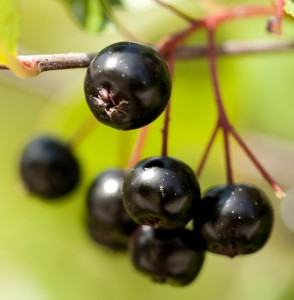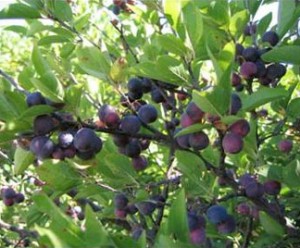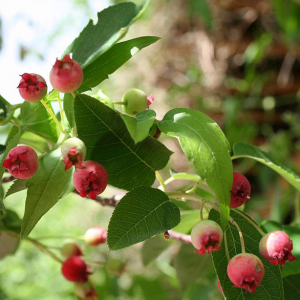The Native Pantry: Wild Wine and Delectable Delights
Posted in Gardening Tips on April 29 2014, by Sonia Uyterhoeven
Sonia Uyterhoeven is the NYBG’s Gardener for Public Education.

When I feel like going on a culinary adventure, I’ll often travel to the Polish markets in Brooklyn’s Greenpoint. It’s one of the few places that I can find one of my favorite items, a drink or syrup made from chokeberries (Aronia melanocarpa). You simply dilute the syrup with mineral water to create a refreshing beverage with a robust berry flavor reminiscent of black currants—minus the bitter edge.
European markets tend to offer a wealth of products like this, many of them made from herbs and berries that you won’t often find in the mainstream North American marketplace. They herald back to a time when people lived off the land and were more intimately connected with their natural environment.
We often assess native plants in terms of their ornamental value, but rarely view them in terms of their culinary value, even though there is a long and colorful history of foraging and using native species in our kitchens. For the most part, these traditions have since been isolated to local communities and small groups of enthusiasts.
On my yearly visits to Cape Cod, I not only beach, bike, and botanize, but I also stock up on beach plum jam. While the chokeberry reminds me of black currants, beach plums (Prunus maritima) taste like a cross between a plum and a red currant. They make a fabulous jelly, and in my household it disappears faster than the wild blueberry jam I often pick up (another good native plant that hit the big time in terms of mass appeal).
Why are natives important? Well, for starters, they are often highly nutritious. There are good reasons why the early settlers adopted Native American foraging practices—not only because they offered a readily available food source, but also for their nutritional value. Beach plums are as high in antioxidants as their famous Cape cousins, the cranberries, and have the same antibacterial antigens that fight off infection.

For those of you who like to imbibe your nutrients, there’s still hope. Beach plum has even become the source of new wines and spirits. To make beach plum wine at home, do-it-yourself wine guru Jack Keller suggests that you allow the wine to age for a year so as “to come into its own.” The aging process helps to get rid of some of the astringency of the drink. Sugar or honey can also be added during the fermentation process, but it is important not to over-sweeten it. For something with a bit more bite, beach plum gin is being made by a local distiller called Greenhook Ginsmiths.
Chokeberries—both the black chokeberry (Aronia melanocarpa) and the red chokeberry (Aronia arbutifolia)—can also be made into wine, and there are several recipes out there to get you started (1, 2).
The black chokeberry that I enjoy so much from the Polish market is commercially grown in European countries such as Denmark and Poland, and is also a successful crop in Russia. The common name chokeberry comes from its high levels of tannin and citric acid. So don’t eat these berries straight off the bush—cook them and add sugar before you pop them into your mouth. Otherwise, you will pucker up for all the wrong reasons.
Another good candidate for alcoholic beverages is the fruit of the prickly pear cactus (Opuntia humifusa). It tastes slightly of sweet watermelon, and though I am personally not crazy about it, I have even enjoyed a prickly pear ice cream. But make sure you are careful when handling the fruit or the foliage—like other cacti, they are covered in nasty spines.
For something a little less treacherous, try making wine from Allegheny serviceberries (Amelanchier laevis), common elderberry (Sambucus canadensis), or even the tropical paw paw (Asimina triloba). If you have a penchant for brewing, the famous forager Euell Gibbons even has a recipe for persimmon (Diospyros virginiana) beer.

Serviceberries (Amelanchier) can vary from tasty to tasteless depending on species and specimen. You can eat the fresh fruit, or use them as a replacement for blueberries in your favorite muffin recipe. In turn, common elderberry can be made into delicious wine or cordials, using both its flowers (elderflower wine) and its fruits (elderberry wine). Other parts of the plant (leaves, roots, and bark) are poisonous and the unripe berries will cause nausea, so you need to know what to harvest. Ripe fruits, however, are loaded with vitamin C, calcium, and potassium, and have been used in cold remedies, weight loss regimens, and herbal arthritis treatments.
Persimmons should be eaten when soft, gooey, and ripe—otherwise they have an astringent quality to them. Gibbons provides a recipe for persimmon-hickory nut bread in Stalking the Wild Asparagus which looks like it’s worth a try.
Many of these edible treats are easy to grow at home and are well-adapted to a wide range of garden conditions. Serviceberries and chokeberries add wonderful ornamental value to any landscape. And while the beach plum grows as a lean specimen by the seashore, I have seen it fill out wonderfully when placed in less severe environments, making an attractive shrub or low hedge (4-6 ft. tall). The added bonus of including these natives in your garden is that, even if you don’t eat the berries, the birds will. Planting natives is a great way to attract wildlife.
Remember: not all berries or plants are edible. Many are poisonous. For certain plants, some parts may be edible while others are not. Even ripeness can drastically affect the edibility of a plant. Choose from reliable sources, follow the recipe, and heed any warnings to the letter. Always make sure that you have properly identified your harvest, and if you’re not certain of your abilities in that arena, skip the foraging and find a reputable supplier!
For those of you who would rather stick to the tried and true grape when selecting your beverages, don’t miss this weekend’s Wine in the Native Plant Garden festival, taking place May 3 and 4 among the Garden’s greatest collection of native species. We will have a number of local wine producers offering samples, as well as food, live music, and more. It’s the perfect seasonal celebration!
Beach plum and serviceberry photos courtesy of Wikimedia Commons.


My black moor ate my black tetras eye?